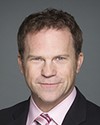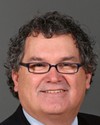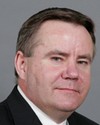You know what? I have that luxury.
In terms of my day-to-day management, as I said, I am the manager of the harbour authority. I was elected by the fishermen. We had 182 eligible voters and I got 168 of the votes. We had a 100% turnout, and I'm happy to say that we did it, because I know it doesn't happen often.
I have a 20-hour-a-week contract, or my contract states that I will work 20 hours a week. I usually work between 40 and 60 hours. I maintain an office on the site at our class A wharf. I take directions from a 15-member board...sometimes I take directions from a 15-member board.
Speaking of our board, I heard someone mention boards and burnout. We renew our board. As I said, we have three wharves; we have a 15-member board, and each wharf has equal representation. We make it like a “you have to serve this year” type of thing, so we change folks around, and it seems to work quite well for us.
I manage the facilities at all three of the wharves. I collect the fees. I assign berthages or work with my board on berthing plans, storage, and landings. I develop, or help to develop with our board, policies, regulations, fee schedules, and we look at rules and regulations that would help to ensure the safe usage of our facility.
I inspect our facility and report any required repairs. I try very hard to ensure compliance—and I'll get to more about that later.
I do just about everything. I manage repair and maintenance contracts. We have now started, just in the last couple of years, providing technological access/computer access to our fishermen in our office, so we're working hard on that. We also try to act as liaison between our fishermen and fisheries-related resources and all three levels of government.
That's a basic outline of what I do.
On the financial responsibilities of our harbour authority, I don't know how familiar everyone is with exactly what we pay. The harbour authority is responsible for the financial end of our operation. We have seven electric light bills. We take care of those. A big thing that's happened lately with our financial responsibility and our electric light bills or our electricity is that now Nova Scotia Power doesn't come on our wharves to repair any of their street lights and whatever, so we have to pay that. We pay for jimmy lifts, for our own electrician to come and do the work, and in the last year that particular area has really skyrocketed in the amount we pay.
On oil disposal, with all of my vessels, there are usually two to three times a year that we do a really major...when everybody's changing their oil and everybody's cleaning up. We consider it very important to do this within environmental parameters, so we have oil disposal buildings. Our oily containers and rags, things like that, are in one spot; our used oil is in another. It's very costly to have this properly disposed of, although within the last two years we were able to identify a source to which we could sell our used oil. So instead of our having to pay to have it removed, we are having it removed and generating a small amount of income.
On garbage disposal, you may not think garbage disposal on three wharves of the size we have is much, but it is a lot. In fact, it probably is costing us about $1,300 a month for garbage disposal.
Snow and ice removal is another factor.
Legal fees have come up just recently. We now have a lawyer who is retained by the harbour authority. There have been several incidents in the last two years for which we've had to use her services, and unfortunately, the number of times we need to use our lawyer is increasing.
Then there is a contribution to funded projects. We do that, of course. As you all probably know, we have a 20-80 split with the small crafts and harbours program on most of our small maintenance projects, our minor works projects, and we also cost share with the provincial government.
One thing that is a financial responsibility of ours is payment for projects while we're waiting for funding. That uses up a huge amount of what little money we have.
Next is revenue generation. I had this down, and I was sitting over there listening and I heard it come up over and over again, and I said, wow, it's good that I included it in what I had to say today, because apparently you're all interested in it.
How do we generate revenue? We're very lucky, in a way, at the harbour authority in Woods Harbour because we have a very lucrative fishery, a large number of boats, and the three different wharves. It's not as if we have one little wharf and six vessels. We generate our revenue through user fees, and that includes berthage fees. That's what each vessel pays, of course, to dock at the wharf. We have licence fees, which include unloading licences, truck access licences, lobster cars. That's about it for the licences. Oh, I also have reefer licences this year, and we have subleases.
We have in the past couple of years endeavoured to increase our revenue generation. When I came on board, it was about three years ago. I don't think anyone had really looked at generating revenue before. But I look at the harbour authority as a business and that perhaps we should be running it as a business to the best of our ability. So I started pushing for increasing revenue. In the last years, we've increased the number of private hoists on the wharves by two and we have also started licensing reefers on the facility--we're unable to increase our subleases--and we will be able to do more as time goes on.
The revenue we generate by user fees is adequate to cover our operational expenses and our minor repairs. We are, however, still entirely dependent on the government for major repair and expansion.
I should say, before stopping there—and this is just my opinion and something we talk a lot about on the board—as far as major repairs and expansions and being dependent on the government is concerned, we don't feel that we should be constantly going to the government with our hand out. It isn't the right way to do business. If we're going to be looking at operating as a business, then we should be taking some responsibility for generating our own revenue.
If I come to you with my hand out and it's empty, you're going to look at me and say too bad for you; you want me to fill it. But if I come to you with two hands and I have something in this one, saying, I can contribute this, but what I need is some help from you in this hand, then I think we're able to do business a little better.
That said, when I talked to Stephen, I asked him what I should talk about. He said to talk about what I do, and about some challenges and problems. So here we are at the problems.
Our number one problem at my harbour authority is overcrowding, lack of space, and I want to talk about that at length.









